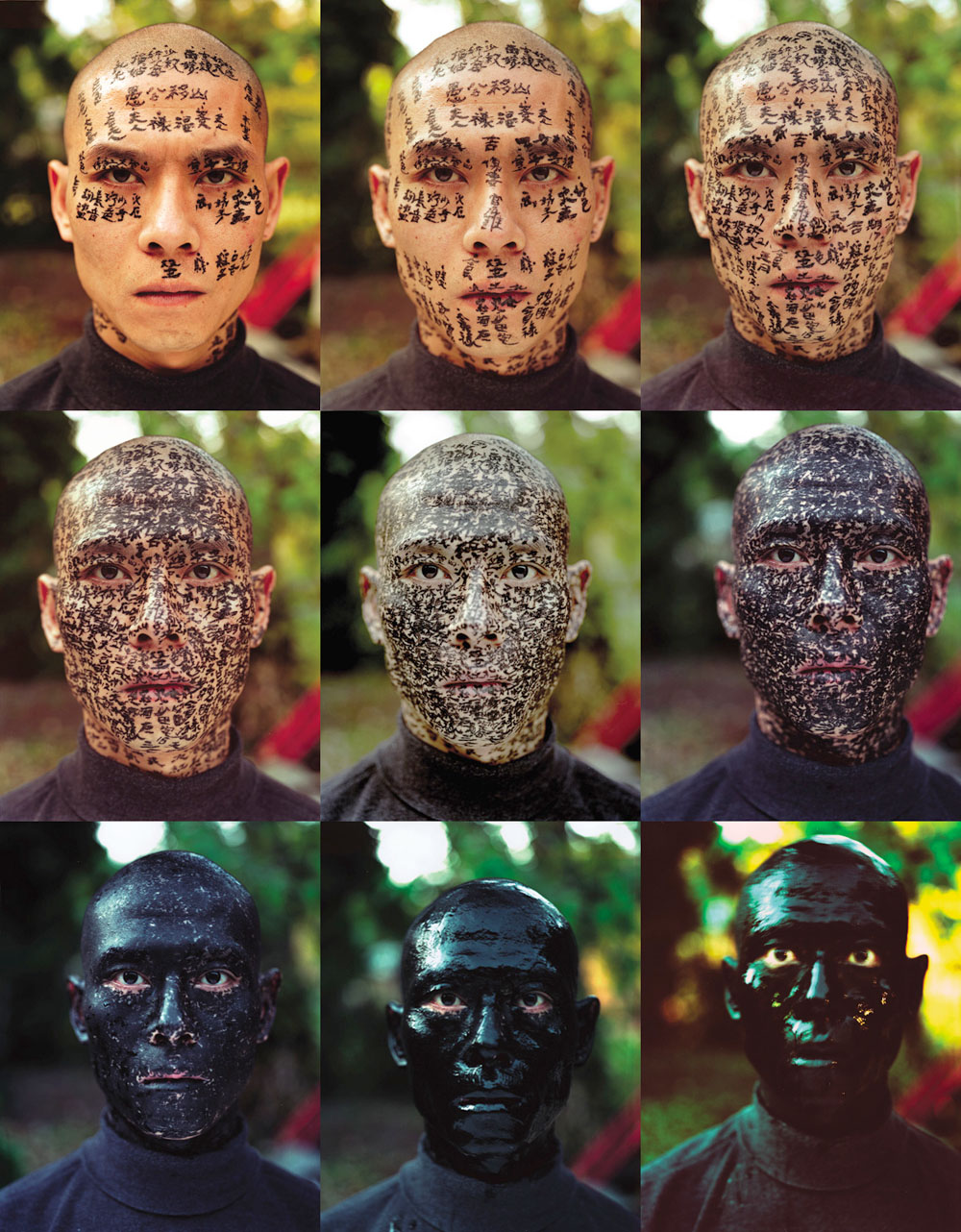China may be well famed for its sprawling natural spaces and traditional heritage, but there’s a buzz of contemporary artists cropping up among the country’s cultural scene. Whilst the nation may not be commonly associated with prolific artists – Ai Weiwei and the late Ren Hang aside – a new wave of artists are reinvigorating the traditional image of China. And, with this fresh energy comes the chance to gain further insight into the expansive country.
Embracing a mix of techniques and styles, with many drawing upon the country’s rich history, whilst others choose to look to the future of the nation or completely juxtapose the traditions of their homeland, here are five contemporary Chinese artists that are creating provocative and thought-provoking artworks that demand a closer look.
Zhang Xiaogang

Exploring his personal identity and that of his culture, Zhang Xiaogang’s paintings evoke a subtle but haunting mix of emotions and memories. Born in Kunming, Yunnan Province, and currently residing in Beijing, the artist’s own experiences are clearly portrayed in his paintings, both through the use of colour and subject matter.

After battling with depression and alcoholism, enduring a stint in hospital in the ‘80s, the artist’s troubled mind can be found in his surrealist works. Faces stare up from the page with gaping and bottomless expressions, and landscapes are depicted as isolated, secluded, and abandoned. The colours are often whitewashed with a greyscale palette and occasional bold splash of red, blue or yellow.
Perhaps his best known body of work is the Bloodlines series from the 1990s, which was directly inspired by old photographs of his family. The collection renders a sense of innocence, purpose, and legacy. The portraits are stoically poised, unblinkingly looking out upon the observer; expressionless, unreadable, and – most interestingly – timeless. Each portrait within the collection shares a number of similarities, touching upon the importance of heritage and descent among Asian cultures, in contrast to individuality, which is so praised among Western cultures.

Often considered one of the most popular Chinese artists of all times, Xiaogang’s total sales volume is believed to be upwards of $310 million (£222 million).
Yue Minjun
Yue Minjun’s paintings are instantly recognisable thanks to his grotesquely grinning subjects and the painter’s vibrant use of colour. Subverting the classicism of Chinese art in favour of pop art and surrealism roots, Minjun’s work is impossible to ignore. 
He juxtaposes the traditional image of the grinning Buddha with that of the cartoonish faces so popular among the pop art movement, choosing to oppose the typical stoicism of Chinese portraiture with that of an endlessly guffawing and uninhibited figure.
The laughing self-portrait of Geng Jianyi is said to have made such an impression on the Minjun, sparking the artist’s own series.

But, the painter has done more than simply translating his own identity onto paper – he has fashioned himself as something of an icon, raising political and social criticisms underneath the exaggerated ear-to-ear smiles painted on his face. Finding his place among China’s contemporary scene within the Cynical Realist movement, the artist is unafraid and unabashed to create works that push boundaries and provoke commentary.

Growing up in the agricultural and somewhat detached province of Heilongjiang and now living in the bustling capital of Beijing, Minjun has been largely inspired by the cultural changes in China that have happened around him, with art theorist Li Xianting describing Minjun’s work as “a self-ironic response to the spiritual vacuum and folly of modern-day China”.
Yang Fudong
Pioneering filmmaker, cinematographer and photographer Yang Fudong combines a hallucinatory dose of dreamy aesthetics alongside his signature surrealistic style. Having originally trained as a painter at the China Academy of Fine Arts in Hangzhou, the filmmaker and photographer utilises his understanding of art, colour and emotion to tell stories on the screen through moving or static pictures. Mostly working in black and white, Fudong focuses on costume, spontaneity and positioning to capture emotive photographs and film sequences.

Perhaps his best loved piece of work is the Seven Intellectuals in a Bamboo Forest film, which is largely inspired by the traditional Chinese idea of the Seven Sages (a group of Chinese scholars, writers and musicians dating back to the 3rd century CE). Presented as five different parts, Fudong draws from his classical art training here to present the shrouded country landscapes like those of masterful paintings, and pays particular attention to the staging and costumes of his characters, all of which is reminiscent of the work of Ingmar Bergman.

When talking about the film, Fudong explains: “The film is about the future […] It is about a group of young people. Their future is not foreseeable. What they do is based on how they feel. Another important point is the disparities between real life and utopian life. This is intended as a question, not an answer.”
He has also collaborated with a number of fashion houses and brands, including for the Prada Spring/ Summer 2010 preview in his film First Spring. The black and white short film has a romantic and mysterious quality to it, following the life of a young man ready to embrace a new career in Shanghai.

He has also collaborated with a number of fashion houses and brands, including for the Prada Spring/ Summer 2010 preview in his film First Spring. The black and white short film has a romantic and mysterious quality to it, following the life of a young man ready to embrace a new career in Shanghai.
Like much of his other work, this film conveys a timeless quality, reflects upon the golden period of Chinese cinema, and looks to typical Chinese adages (in this instance the whole year’s work depends on a good start in spring) to create an evocative message.
Zhang Huan

Conceptual artist Zhang Huan offers a gutsy and visceral focus on the human body through his photography, paintings, sculptures and performances. Huan is not one to shy away from typically taboo subject matters, sparking conversations (both critical and positive) about his exploration of nude bodies in his photography and his masochistic performances.
Testing his mental and physical capabilities, his performance art encompasses a number of different social themes, most prominently the power of unity when challenging oppressive political regimes; the plight of expatriates in today’s world; the role and persistence of faith among communities ridden with violent conflict; and the presence of censorship in contemporary democracy.

Spanning nearly 40 different pieces, his most well known performances include Angel and Family Tree. In the former, the artist stood on a large white canvas as red liquid (representing blood) and mangled doll parts were poured over him. He then took the doll parts and attempted to reassemble them on the canvas – a stark and heart-rending comment about China’s restrictive abortion laws and the controversial one-child policy.
Family Tree delves into the topics of heritage and identity, consisting of nine self-portraits, taken from dawn until dusk, of the artist covered in calligraphy of his own personal tales and innermost thoughts. Each subsequent photograph is more censored, until the calligraphy on the artist’s face is completely illegible, as a black smudge, suggesting a lineage blurred through time and the necessity for uniqueness in today’s society.
Liu Wei
Experimenting with multiple mediums, Beijing-based abstract artist Liu Wei depicts urban life, commenting on the industrialisation and modernisation of China. His works contain striking imagery of buildings, skyscrapers and cities, evoking a sense of both the busyness and the claustrophobic nature of China’s sprawling metropolises. Explaining his own inspirations, Wei has said: “Cities are reality; all of China is a city under construction, and of course this influences me”.
The artist oftens uses readily available materials to form his works, choosing household objects and discarded items from everyday life, such as scrap metal, broken electrical appliances, mirrors, and the torn pages of books. It is precisely this eclectic mix of mediums and the diversity that his collection of works encompass that makes the artist so prolific – no two pieces of artwork are alike; for Wei, originality is essential.

Serpentine Gallery curator, Hans Ulrich Obrist explained the artist’s choice of materials, saying: “He builds a crystal palace made out of recycled materials but, in this way, he is as much anti-architecture and anti-urbanism as he is an urbanist,” says Obrist. Whether through his paintings, sculptures or installations, Wei commands attention, offering disorientating yet captivating visuals. For example, one of his most famed pieces Indigestion II consists of, on the surface, a three-dimensional turd. But, looking closer it’s possible to see tiny toy soldier figures, model aeroplanes, and instruments of war amid the excrement. The installation was formed from tar, and offers a less-than-subtle critique on consumerism, corruption, and the global conflict over energy resources.
Similarly, Love It! Bite It! parodies consumption and the strength the nation places upon heritage, depicting a skeletal cityscape made entirely from the dried gut ingredients of dog chews.

These are just five contemporary Chinese artists making an impression upon a global scale, but the Chinese art scene continues to flourish with intensity and vigour, both embracing and relinquishing cultural traditions.



